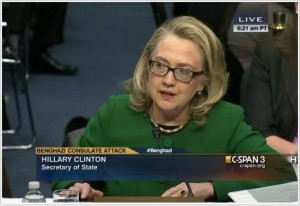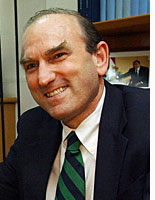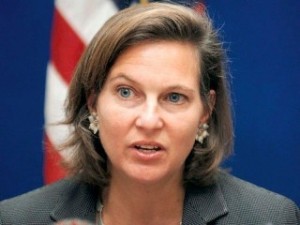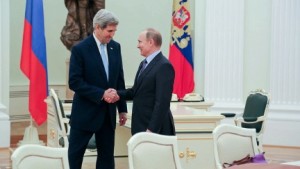Over the past several decades, the U.S. State Department has deteriorated from a reasonably professional home for diplomacy and realism into a den of armchair warriors possessed of imperial delusions, a dangerous phenomenon underscored by the recent mass “dissent” in favor of blowing up more people in Syria.
Some 51 State Department “diplomats” signed a memo distributed through the official “dissent channel,” seeking military strikes against the Syrian government of Bashar al-Assad whose forces have been leading the pushback against Islamist extremists who are seeking control of this important Mideast nation.
The fact that such a large contingent of State Department officials would openly advocate for an expanded aggressive war in line with the neoconservative agenda, which put Syria on a hit list some two decades ago, reveals how crazy the State Department has become.
The State Department now seems to be a combination of true-believing neocons along with their liberal-interventionist followers and some careerists who realize that the smart play is to behave toward the world as global proconsuls dictating solutions or seeking “regime change” rather than as diplomats engaging foreigners respectfully and seeking genuine compromise.
Even some State Department officials, whom I personally know and who are not neocons/liberal-hawks per se, act as if they have fully swallowed the Kool-Aid. They talk tough and behave arrogantly toward inhabitants of countries under their supervision. Foreigners are treated as mindless objects to be coerced or bribed.
So, it’s not entirely surprising that several dozen U.S. “diplomats” would attack President Barack Obama’s more temperate position on Syria while positioning themselves favorably in anticipation of a Hillary Clinton administration, which is expected to authorize an illegal invasion of Syria — under the guise of establishing “no-fly zones” and “safe zones” — which will mean the slaughter of young Syrian soldiers. The “diplomats” urge the use of “stand-off and air weapons.”
These hawks are so eager for more war that they don’t mind risking a direct conflict with Russia, breezily dismissing the possibility of a clash with the nuclear power by saying they are not “advocating for a slippery slope that ends in a military confrontation with Russia.” That’s reassuring to hear.
Risking a Jihadist Victory
There’s also the danger that a direct U.S. military intervention could collapse the Syrian army and clear the way for victory by Al Qaeda’s Nusra Front or the Islamic State. The memo did not make clear how the delicate calibration of doing just enough damage to Syria’s military while avoiding an outright jihadist victory and averting a clash with Russia would be accomplished.
Presumably, whatever messes are created, the U.S. military would be left to clean up, assuming that shooting down some Russian warplanes and killing Russian military personnel wouldn’t escalate into a full-scale thermonuclear conflagration.
In short, it appears that the State Department has become a collective insane asylum where the inmates are in control. But this madness isn’t some short-term aberration that can be easily reversed. It has been a long time coming and would require a root-to-branch ripping out of today’s “diplomatic” corps to restore the State Department to its traditional role of avoiding wars rather than demanding them.
Though there have always been crazies in the State Department – usually found in the senior political ranks – the phenomenon of an institutional insanity has only evolved over the past several decades. And I have seen the change.
I have covered U.S. foreign policy since the late 1970s when there was appreciably more sanity in the diplomatic corps. There were people like Robert White and Patricia Derian (both now deceased) who stood up for justice and human rights, representing the best of America.
But the descent of the U.S. State Department into little more than well-dressed, well-spoken but thuggish enforcers of U.S. hegemony began with the Reagan administration. President Ronald Reagan and his team possessed a pathological hatred of Central American social movements seeking freedom from oppressive oligarchies and their brutal security forces.
During the 1980s, American diplomats with integrity were systematically marginalized, hounded or removed. (Human rights coordinator Derian left at the end of the Carter administration and was replaced by neocon Elliott Abrams; White was fired as U.S. ambassador to El Salvador, explaining: “I refused a demand by the secretary of state, Alexander M. Haig Jr., that I use official channels to cover up the Salvadoran military’s responsibility for the murders of four American churchwomen.”)
The Neocons Rise
As the old-guard professionals left, a new breed of aggressive neoconservatives was brought in, the likes of Paul Wolfowitz, Robert McFarlane, Robert Kagan and Abrams. After eight years of Reagan and four years of George H.W. Bush, the State Department was reshaped into a home for neocons, but some pockets of professionalism survived the onslaughts.
While one might have expected the Democrats of the Clinton administration to reverse those trends, they didn’t. Instead, Bill Clinton’s “triangulation” applied to U.S. foreign policy as much as to domestic programs. He was always searching for that politically safe “middle.”
As the 1990s wore on, the decimation of foreign policy experts in the mold of White and Derian left few on the Democratic side who had the courage or skills to challenge the deeply entrenched neocons. Many Clinton-era Democrats accommodated to the neocon dominance by reinventing themselves as “liberal interventionists,” sharing the neocons’ love for military force but justifying the killing on “humanitarian” grounds.
This approach was a way for “liberals” to protect themselves against right-wing charges that they were “weak,” a charge that had scarred Democrats deeply during the Reagan/Bush-41 years, but this Democratic “tough-guy/gal-ism” further sidelined serious diplomats favoring traditional give-and-take with foreign leaders and their people.
So, you had Democrats like then-U.S. Ambassador to the United Nations (and later Secretary of State) Madeleine Albright justifying Bill Clinton’s brutal sanctions policies toward Iraq, which the U.N. blamed for killing 500,000 Iraqi children, as “a very hard choice, but the price – we think the price is worth it.”
Bill Clinton’s eight years of “triangulation,” which included the brutal air war against Serbia, was followed by eight years of George W. Bush, which further ensconced the neocons as the U.S. foreign policy establishment.
By then, what was left of the old Republican “realists,” the likes of Henry Kissinger and Brent Scowcroft, was aging out or had been so thoroughly compromised that the neocons faced no significant opposition within Republican circles. And, Official Washington’s foreign-policy Democrats had become almost indistinguishable from the neocons, except for their use of “humanitarian” arguments to justify aggressive wars.
Media Capitulation
Before George W. Bush’s invasion of Iraq, much of the “liberal” media establishment – from The New York Times to The New Yorker – fell in line behind the war, asking few tough questions and presenting almost no obstacles. Favoring war had become the “safe” career play.
But a nascent anti-war movement among rank-and-file Democrats did emerge, propelling Barack Obama, an anti-Iraq War Democrat, to the 2008 presidential nomination over Iraq War supporter Hillary Clinton. But those peaceful sentiments among the Democratic “base” did not reach very deeply into the ranks of Democratic foreign policy mavens.
So, when Obama entered the White House, he faced a difficult challenge. The State Department needed a thorough purging of the neocons and the liberal hawks, but there were few Democratic foreign policy experts who hadn’t sold out to the neocons. An entire generation of Democratic policy-makers had been raised in the world of neocon-dominated conferences, meetings, op-eds and think tanks, where tough talk made you sound good while talk of traditional diplomacy made you sound soft.
By contrast, more of the U.S. military and even the CIA favored less belligerent approaches to the world, in part, because they had actually fought Bush’s hopeless “global war on terror.” But Bush’s hand-picked, neocon-oriented high command – the likes of General David Petraeus – remained in place and favored expanded wars in both Iraq and Afghanistan.
Obama then made one of the most fateful decisions of his presidency. Instead of cleaning house at State and at the Pentagon, he listened to some advisers who came up with the clever P.R. theme “Team of Rivals” – a reference to Abraham Lincoln’s first Civil War cabinet – and Obama kept in place Bush’s military leadership, including Robert Gates as Secretary of Defense, and reached out to hawkish Sen. Hillary Clinton to be his Secretary of State.
In other words, Obama not only didn’t take control of the foreign-policy apparatus, he strengthened the power of the neocons and liberal hawks. He then let this powerful bloc of Clinton-Gates-Petraeus steer him into a foolhardy counterinsurgency “surge” in Afghanistan that did little more than get 1,000 more U.S. soldiers killed along with many more Afghans.
Obama also let Clinton sabotage his attempted outreach to Iran in 2010 seeking constraints on its nuclear program and he succumbed to her pressure in 2011 to invade Libya under the false pretense of establishing a “no-fly zone” to protect civilians, what became a “regime change” disaster that Obama has ranked as his biggest foreign policy mistake.
The Syrian Conflict
Obama did resist Secretary Clinton’s calls for another military intervention in Syria although he authorized some limited military support to the allegedly “moderate” rebels and allowed Saudi Arabia, Qatar and Turkey to do much more in supporting jihadists connected to Al Qaeda and even the Islamic State.
Under Secretary Clinton, the neocon/liberal-hawk bloc consolidated its control of the State Department diplomatic corps. Under neocon domination, the State Department moved from one “group think” to the next. Having learned nothing from the Iraq War, the conformity continued to apply toward Libya, Syria, Afghanistan, Ukraine, Russia, China, Venezuela, etc.
Everywhere the goal was same: to impose U.S. hegemony, to force the locals to bow to American dictates, to steer them into neo-liberal “free market” solutions which were often equated with “democracy” even if most of the people of the affected countries disagreed.
Double-talk and double-think replaced reality-driven policies. “Strategic communications,” i.e., the aggressive use of propaganda to advance U.S. interests, was one watchword. “Smart power,” i.e., the application of financial sanctions, threats of arrests, limited military strikes and other forms of intimidation, was another.
Every propaganda opportunity, such as the Syrian sarin attack in 2013 or the Malaysia Airlines Flight 17 shoot-down over eastern Ukraine, was exploited to the hilt to throw adversaries on the defensive even if U.S. intelligence analysts doubted that evidence supported the accusations.
Lying at the highest levels of the U.S. government – but especially among the State Department’s senior officials – became epidemic. Perhaps even worse, U.S. “diplomats” seemed to believe their own propaganda.
Meanwhile, the mainstream U.S. news media experienced a similar drift into the gravity pull of neocon dominance and professional careerism, eliminating major news outlets as any kind of check on official falsehoods.
The Up-and-Comers
The new State Department star – expected to receive a high-level appointment from President Clinton-45 – is neocon Assistant Secretary of State for European Affairs Victoria Nuland, who orchestrated the 2014 putsch in Ukraine, toppling an elected, Russia-friendly president and replacing him with a hard-line Ukrainian nationalist regime that then launched violent military attacks against ethnic Russians in the east who resisted the coup leadership.
When Russia came to the assistance of these embattled Ukrainian citizens, including agreeing to Crimea’s request to rejoin Russia, the State Department and U.S. mass media spoke as one in decrying a “Russian invasion” and supporting NATO military maneuvers on Russia’s borders to deter “Russian aggression.”
Anyone who dares question this latest “group think” – as it plunges the world into a dangerous new Cold War – is dismissed as a “Kremlin apologist” or “Moscow stooge” just as skeptics about the Iraq War were derided as “Saddam apologists.” Virtually everyone important in Official Washington marches in lock step toward war and more war. (Victoria Nuland is married to Robert Kagan, making them one of Washington’s supreme power couples.)
So, that is the context of the latest State Department rebellion against Obama’s more tempered policies on Syria. Looking forward to a likely Hillary Clinton administration, these 51 “diplomats” have signed their name to a “dissent” that advocates bombing the Syrian military to protect Syria’s “moderate” rebels who – to the degree they even exist – fight mostly under the umbrella of Al Qaeda’s Nusra Front and its close ally, Ahrar al Sham.
The muddled thinking in this “dissent” is that by bombing the Syrian military, the U.S. government can enhance the power of the rebels and supposedly force Assad to negotiate his own removal. But there is no reason to think that this plan would work.
In early 2014, when the rebels held a relatively strong position, U.S.-arranged peace talks amounted to a rebel-dominated conference that made Assad’s departure a pre-condition and excluded Syria’s Iranian allies from attending. Not surprisingly, Assad’s representative went home and the talks collapsed.
Now, with Assad holding a relatively strong hand, backed by Russian air power and Iranian ground forces, the “dissenting” U.S. diplomats say peace is impossible because the rebels are in no position to compel Assad’s departure. Thus, the “dissenters” recommend that the U.S. expand its role in the war to again lift the rebels, but that would only mean more maximalist demands from the rebels.
Serious Risks
This proposed wider war, however, would carry some very serious risks, including the possibility that the Syrian army could collapse, opening the gates of Damascus to Al Qaeda’s Nusra Front (and its allies) or the Islamic State – a scenario that, as The New York Times noted, the “memo doesn’t address.”
Currently, the Islamic State and – to a lesser degree – the Nusra Front are in retreat, chased by the Syrian army with Russian air support and by some Kurdish forces with U.S. backing. But those gains could easily be reversed. There is also the risk of sparking a wider war with Iran and/or Russia.
But such cavalier waving aside of grave dangers is nothing new for the neocons and liberal hawks. They have consistently dreamt up schemes that may sound good at a think-tank conference or read well in an op-ed article, but fail in the face of ground truth where usually U.S. soldiers are expected to fix the mess.
We have seen this wishful thinking go awry in Iraq, Afghanistan, Libya, Ukraine and even Syria, where Obama’s acquiescence to provide arms and training for the so-called “unicorns” – the hard-to-detect “moderate” rebels – saw those combatants and their weapons absorbed into Al Qaeda’s or Islamic State’s ranks.
Yet, the neocons and liberal hawks who control the State Department – and are eagerly looking forward to a Hillary Clinton presidency – will never stop coming up with these crazy notions until a concerted effort is made to assess accountability for all the failures that that they have inflicted on U.S. foreign policy.
As long as there is no accountability – as long as the U.S. president won’t rein in these warmongers – the madness will continue and only grow more dangerous.
[For more on this topic, see Consortiumnews.com’s “Democrats Are Now the Aggressive War Party” and “Would a Clinton Win Mean More Wars?’]
Investigative reporter Robert Parry broke many of the Iran-Contra stories for The Associated Press and Newsweek in the 1980s. You can buy his latest book, America’s Stolen Narrative, either in print here or as an e-book (from Amazon and barnesandnoble.com).









